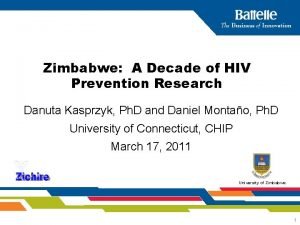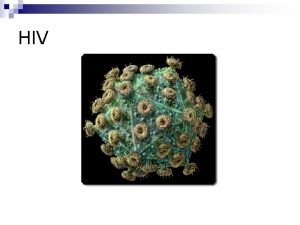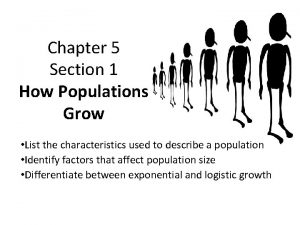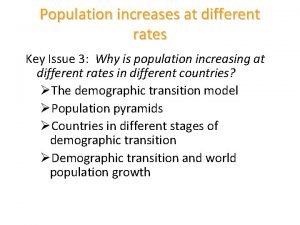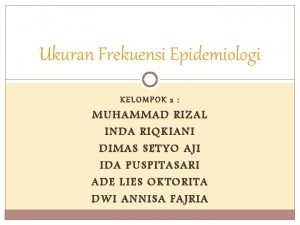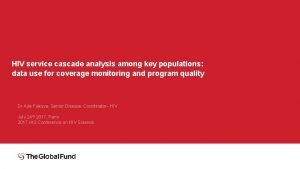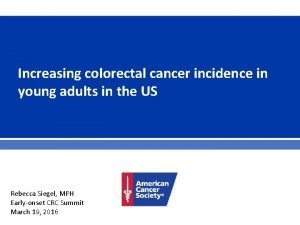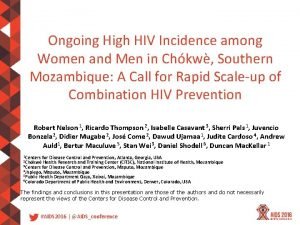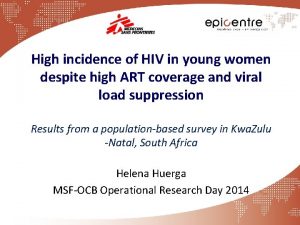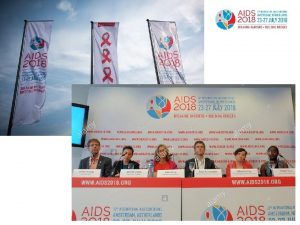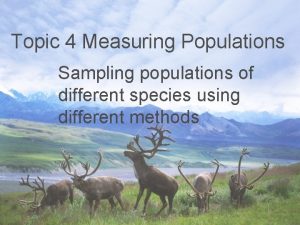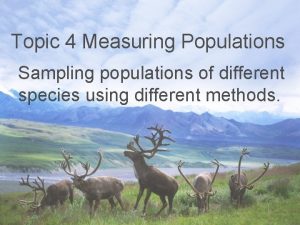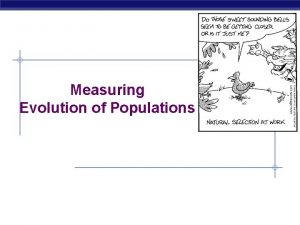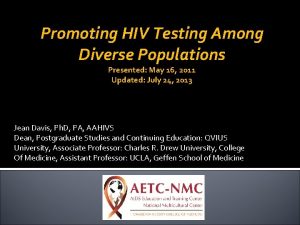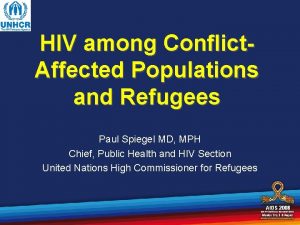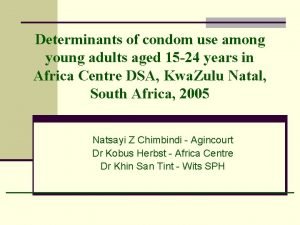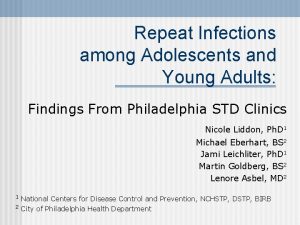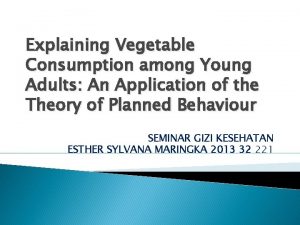Measuring HIV Incidence among Key Populations Young Adults



























- Slides: 27

Measuring HIV Incidence among Key Populations, Young Adults and Adolescents July 22 nd, 2018 Joep Lange Institute, Amsterdam Jessica E. Justman, M. D. Senior Technical Director ICAP at Columbia

Disclosure of Speaker’s Interests • No conflict of interests

Overview Measuring HIV Incidence among Key Populations, Young Adults and Adolescents • Background - Why measure HIV incidence - Current HIV incidence estimates • Methods: focus on direct measures and sampling • Challenges • Future

Why Measure HIV Incidence? • Measure ‘leading edge’ of epidemic – Quantify number of new infections – Expose trends, risk factors and risk groups • Guide prevention efforts – Essential tool in HIV prevention clinical trials – Assess impact of prevention and treatment programs • Identify who is missing out on benefit of efforts • Aid advocacy and accountability efforts

Definition of Priority Populations (PP) • Population groups at elevated risk of new infection based on specific demographic features who account for large numbers of new HIV infections* – Adolescent girls and young women (AGYW), and young men are main PP in high prevalence settings, particularly sub -Saharan Africa • Depending on the context, PP also include: – Prisoners, partners of PWID, and other vulnerable or marginalized groups (e. g. , migrants, refugees) – Certain occupational groups such as miners, fishermen, farm workers, truck drivers, and uniformed personnel *http: //www. unaids. org/sites/default/files/media_asset/20151019_JC 2766_Fast-tracking_combination_prevention. pdf Pgs. 14 -15

Definition of Key Populations (KP) • Population groups at elevated risk of new infection based on specific risk behaviors • May vary by country but common features: – Higher prevalence than general population – Often a marginalized, stigmatized, “hard-to-reach” group – Resources may not be geared to needs of group • UNAIDS Key Populations*: – People who inject drugs (PWID) – Gay men, men who have sex with men (MSM) – Transgender persons – Sex workers and their clients *http: //www. unaids. org/en/topic/key-populations

Estimates of Global Number of New HIV Infections Estimates of new infections largely based on models 1. 8 million 1990 2020

PHIA Project: National HIV Incidence Measures Population-based HIV Impact assessments (PHIA): - nationally representative, HIVfocused household surveys to assess the status of the HIV epidemic and the impact of national programs through: • 1 o : National HIV incidence and prevalence of viral load suppression • 2 o objectives: Adult and pediatric HIV prevalence, drug resistance, detectable ARVs CD 4 distribution, among others phia. icap. columbia. edu

National HIV Incidence General Population, Adults (15– 49 years) Total Annual HIV Incidence, Age 15 -49 (%) 3. 0 Male Female 2. 0 1. 8 2. 5 1. 5 2. 0 1. 0 0. 5 0. 0 1. 1 1. 5 0. 7 0. 5 0. 3 0. 5 0. 4 0. 3 Zimbabwe Malawi phia. icap. columbia. edu 1. 61. 3 0. 7 0. 3 0. 4 0. 3 0. 1 Zambia Tanzania Swaziland Lesotho

HIV Incidence in Priority Populations: Adolescents & Young Adults In 2016, youth ages 15 -24 accounted for 34% of all global new infections (610, 000) • Gender: 2/3 new infections among youth are in adolescent girls • Location: most (73%) new infections among adolescents occur in sub. Saharan Africa Source: UNAIDS 2017 estimates Data not available for North America # and % new HIV infections among AGYW 15 -19, by region, 2016

Key Populations are a Large Source of New HIV Infections 1. 9 million new HIV infections in 2015 • Of these, key populations and their sexual partners comprised: o 80% of all new infections outside SSA o 25% of all new infections in SSA o 44% of new HIV infections globally

Methods: Directly Observed Incidence Measurements • Prospective cohort studies – Based on observed HIV diagnosis (seroconversions) – Considered “gold standard” of direct measurement, but… – Expensive, difficult, time-consuming and prone to bias HIV-uninfected Cohort HIV testing

Methods: Directly Observed Incidence Measurements • Cross-sectional estimation using biomarkers – Using lab assays of individual blood samples, identify recent infections (last 4 -6 months) and acute (A) infections (last 2 weeks) – Ex: LAg-avidity assay (used in PHIAs) for recent – Pooled nucleic acid testing (NAT) for acute Recently infected Individuals A Window period (e. g. , 6 mo. ) Time of infection Time of sampling

Sampling: General Population Estimates PHIA Project and other general population survey Two-stage, cluster sample designed to achieve nationally representative sample phia. icap. columbia. edu

Oversampling for Priority Population Estimates • Problem: priority population, such as AGYW, may be a large component of the general population but be too small for a reliable sub-estimate • Solution: adjust survey design so that group makes up a larger share of the survey sample than they do in the population • Allows better estimate attributes (incidence) of the group • Weighting used to estimate size of population

Sampling Methods for KP Surveys • Respondent-driven sampling (snowball sampling) – Members of hard-to-reach group refer additional people within their group to the survey – Study procedures are completed – Non-random sampling is later adjusted through mathematical weighting to compensate for biases Wirtz AL, et al. , 2013

Sampling Methods for KP Surveys • Venue-based sampling – Recruitment of target population at venues where the target population gathers – Construction of a sampling frame for venue day/time units helps approximate random sampling • Both respondent driven and venue based sampling used to estimate HIV incidence of target group • KP size estimation methods to calculate burden, e. g. : – Network scale-up – Catch and release

The “Blue Book” on Key Population Surveys • Tools for conducting surveys with KPs • Includes all basic aspects of survey methodology • Provide guidance on: – Biomarker considerations – Population size estimation – Questionnaire modules – Standard and newly proposed indicators

Challenges: HIV Incidence Estimates • Large sample sizes required – even in high incidence settings – applies to all direct methods and drives cost Total person-year observations required for 2 -arm trial Power=0. 80, alpha=0. 05, 2 -sided Annual HIV incidence 1. 5% 2% 3% Relative risk = 0. 5 Relative risk = 0. 6 6, 208 4, 638 3, 068 10, 338 7, 722 5, 106 • Hawthorne effect – Change in behavior related to being observed in a study – limitation of prospective studies and relative advantage of crosssectional surveys

Challenges with Incidence Estimates • Retention – the ability to keep study participants enrolled until all study procedures have been completed – if highest risk individuals are lost, estimate will be lower than actual rate • Accuracy of testing algorithm – Ability to distinguish recent from chronic infections – Depends on antibody maturation response and performance characteristics of assay in specific population

Challenges with Incidence Estimates • Cross-sectional biomarker tests: ideal vs reality Probability of positive test for recent infection Ideal assay for recent infection Realistic assay for recent infection “window period” “tail”

What Existing Incidence Estimates Don’t Tell Us • What is happening at other points in time and changes in incidence trends • When, where and how target population is most at risk • Impact and extent of migration into and out of specific areas • Lack of data in some areas (e. g. Russia and the Middle East) Insufficient detail to inform the type of interventions needed

Future of HIV Incidence Measures: The Search for Surrogates • Trends in population viral load measures as surrogates for HIV incidence – Require lower sample sizes than cross-sectional lab assay incidence estimation – Viremia among PLHIV versus viremia among entire (sub) population • Biomarker discovery trial – Improved recency assays that take fuller advantage of antibody maturation patterns – Other biomarkers (e. g. , IP-10) to screen for inflammatory markers of acute HIV infection IP-10 = Interferon-γ–Inducible Protein 10

The Future of Incidence Measures • Rapid HIV recency testing – May be used to estimate incidence and improve surveillance without altering routine HIV care – Results in minutes – Ease-of-use may also facilitate measurements in PP and KP groups • e. g. , Asante assay

Many Unanswered Questions Remain • Will ART and Pr. EP scale-up make recency assays harder to use? • Are there other ways to measure viral exposure besides host antibody and inflammatory markers? • Do we still need directly observed incidence? – Is it necessary to track outcomes of HIV-uninfected individuals to monitor the epidemic – Or would it be sufficient to track parameters of HIV-infected individuals, such as proportion on ART, proportion with high viral load?

Summary and Conclusion • Direct measures of HIV incidence important for PP, KP and all populations – Assess the ‘leading edge’ and guide prevention efforts • Methods for PP and KP incidence measurement: – Testing technology influences design for all populations – Sampling is challenge for all measures of incidence • Recency assays: improving technology – Better ways to distinguish recent antibody profile – Rapid, point-of-care methods • Combination of indicators as the way forward

Thank You ICAP: Johnny Wylie and colleagues JLI: David Barr and colleagues
 Formula for attack rate
Formula for attack rate Prevalence vs incidence
Prevalence vs incidence Hiv in adults
Hiv in adults Hiv in adults
Hiv in adults Section 19-1 review understanding populations answer key
Section 19-1 review understanding populations answer key Fdic money smart for young adults
Fdic money smart for young adults Is rap music more popular among young
Is rap music more popular among young Lesson 1 populations answer key
Lesson 1 populations answer key Section 5-3 human population growth
Section 5-3 human population growth Chapter 17 evolution of populations answer key
Chapter 17 evolution of populations answer key 5-1 how populations grow
5-1 how populations grow Chapter 10 comparing two populations or groups answer key
Chapter 10 comparing two populations or groups answer key Tripadvisor business model canvas
Tripadvisor business model canvas Key partners key activities key resources
Key partners key activities key resources Key issue 3: why do individual languages vary among places?
Key issue 3: why do individual languages vary among places? Key issue 3 why does population growth vary among regions
Key issue 3 why does population growth vary among regions Perpendicular incidence
Perpendicular incidence Cara hitung insiden rate
Cara hitung insiden rate Secondary attack rate rumus
Secondary attack rate rumus Fracture sous tuberculaire
Fracture sous tuberculaire Oriented incidence matrix
Oriented incidence matrix Critical angle formula
Critical angle formula Walk dengan semua ruas dalam barisan berbeda
Walk dengan semua ruas dalam barisan berbeda How to calculate cumulative incidence example
How to calculate cumulative incidence example Prevalence vs incidence
Prevalence vs incidence Incidence matrix
Incidence matrix Ligament tafa cheville
Ligament tafa cheville Complexe de buford épaule
Complexe de buford épaule


